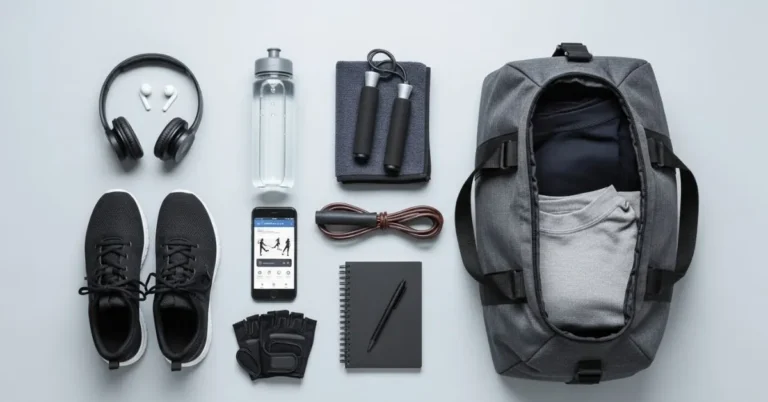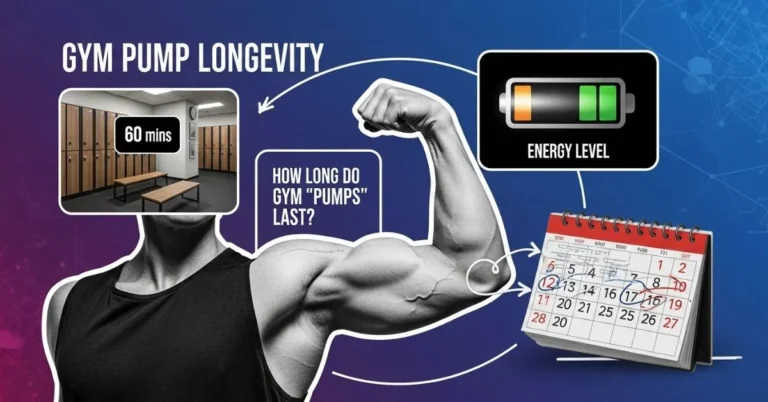
How long should you spend at the gym per day building Muscles? Let’s rewind to a random Tuesday. You walk into the gym, armed with a new tank top, wireless earbuds, and your trusty blender bottle sloshing with protein powder. Today’s the day you finally get serious about building Muscle. But somewhere between stretching next to the cable machine and your third trip to the water fountain, a thought hits you:
“Am I doing too much? Or not enough?”
You glance around.
Some people sprint from set to set like they’re in a timed CrossFit challenge. Others? They’re 90 minutes into their routine and still doing bicep curls like they have nowhere else to be.
If you’re stuck wondering what the ideal gym session looks like for muscle growth without burning out or wasting time you’re not alone. Let’s break down what matters.
Contents
- 1 So, How Long Should You Spend at the Gym Per Day to Build Muscle?
- 1.1 Why 45–75 Minutes Is the Muscle-Building Sweet Spot
- 1.2 What Factors Affect Your Gym Session Length?
- 1.3 Build Smarter: The Weekly Muscle Routine That Works
- 1.4 Short on time? Use Supersets and Circuits
- 1.5 What Happens If You Train Too Long?
- 1.6 Muscles Are Built Outside the Gym Too
- 1.7 Trend Alert: Sustainable, Efficient Workouts
- 1.8 The 3 Golden Rules to Answer: How Long Should You Spend at the Gym Per Day?
- 1.9 FAQs: Your Top Gym time Questions, Answered
- 1.9.1 1. How long should you spend at the gym daily to build Muscle as a beginner?
- 1.9.2 2. What’s the ideal number of gym days per week for muscle growth?
- 1.9.3 3. Is 2 hours at the gym too much?
- 1.9.4 4. Can you build Muscle with 30-minute workouts?
- 1.9.5 5. Should I take rest days even if I feel fine?
- 1.10 Expert Thoughts: Less time, More Muscle
- 1.11 About the Author
So, How Long Should You Spend at the Gym Per Day to Build Muscle?
Let’s get the headline answer out of the way:
Aim for 45 to 75 minutes per session
That’s the golden zone for effective muscle-building
This time range allows you to warm up, focus on hypertrophy-based training, take proper rest intervals, and wrap up with a cooldown, without pushing your cortisol (stress hormone) levels into overdrive.
But the real question isn’t just how long, how smart.
You could be at the gym for 2 hours, make minimal progress, or crush a muscle-building session in 45 minutes. Quality beats quantity every single time.
Why 45–75 Minutes Is the Muscle-Building Sweet Spot
Let’s talk science (don’t worry, no lab coat required):
During weight training, your muscles experience small tears. When you rest, eat well, and sleep, they repair bigger and stronger.
But past 75–90 minutes, your body starts secreting higher levels of cortisol, which:
- Inhibits muscle recovery
- Increases fatigue
- Lowers testosterone levels
Long story short? If your workout consistently drags on, your body stops thriving and starts surviving.
Unless you’re training for a bodybuilding competition or Olympic lifting, there’s no reason to hang around longer than 75 minutes.
What Factors Affect Your Gym Session Length?
- Your fitness level: Beginners don’t need marathon sessions just focused form and consistency.
- Your training goals: Strength-focused sessions (with heavy lifts) require longer rest, while hypertrophy workouts (moderate weight, higher reps) move faster.
- Your rest intervals: Thirty seconds vs. 3 minutes between sets makes a big difference.
- Your schedule: You only have 40 minutes between meetings. That’s okay. You can still grow Muscle.
Read More: How Old Do You Have to Go to a Gym? Age Rules Explained
Build Smarter: The Weekly Muscle Routine That Works
Want to maximize gym time and gains? Try a split training schedule.
Here’s a sample 5-day split that keeps each session within that 45–75 minute sweet spot:
- Monday – Chest & Triceps: Bench press, incline dumbbells, dips, skull crushers
- Tuesday – Back & Biceps: Deadlifts, lat pulldowns, rows, curls
- Wednesday – Legs: Squats, lunges, leg press, hamstring curls
- Thursday – Shoulders & Core: Overhead press, lateral raises, planks
- Friday – Active Recovery / Mobility / Cardio
Tool Tip: Download a gym tracking app like Strong, JEFIT, or Fitbod to log sets, stay on pace, and get personalized workout templates.
Short on time? Use Supersets and Circuits
If you’ve got just 30 minutes, don’t stress. You don’t need to abandon your muscle-building goals.
Try this approach:
- Supersets (pair two exercises back-to-back without rest)
- Giant sets (three or more exercises in a row)
- Rest-pause training (break up one set into smaller efforts with short rests)
These methods maximize time under tension, a critical factor for hypertrophy.
Translation: Shorter workouts can still grow Muscle if done efficiently.
What Happens If You Train Too Long?
Overtraining is a sneaky enemy.
If you’re regularly working out for 90+ minutes with high volume and intensity, here’s what might show up:
- Constant muscle soreness (even after rest days)
- Decreased strength or progress
- Trouble sleeping
- Mood swings or irritability
- Higher injury risk
Listen to your body. More time in the gym doesn’t always equal more results.
Muscles Are Built Outside the Gym Too
Your actual growth happens between workouts, not during them.
That means you need:
- 7–9 hours of sleep per night
- Sufficient protein intake (aim for 0.7–1g per pound of bodyweight)
- Rest days (2–3 per week, depending on your split)
Recommended Guide: Bigger Leaner Stronger by Michael Matthews. It’s beginner-friendly, science-backed, and super affordable perfect for structuring gym time efficiently.
Trend Alert: Sustainable, Efficient Workouts
These days, fitness isn’t just about how long you lift it’s about how your lifestyle supports it.
Here’s what’s trending:
- Minimalist workouts: Dumbbells, resistance bands, and bodyweight exercises that deliver serious results in under an hour
- Hybrid training: Combine gym + home workouts for flexibility
- Sustainable gyms: Eco-conscious fitness centers with energy-saving equipment and water refill stations
- Mobility & recovery tools: Massage balls, stretch apps, and mindfulness recovery days are becoming part of muscle-building culture
Bonus Tip: Stay focused and motivated by using curated fitness podcasts or guided lifting playlists.
The 3 Golden Rules to Answer: How Long Should You Spend at the Gym Per Day?
Let’s make it simple:
- Stick to 45–75 minutes per session: Long enough for effectiveness, short enough to stay consistent.
- Focus on progressive overload, not time: Track your reps, weights, and improvements not just the clock.
- Make it sustainable: The best workout plan is the one you’ll stick to. Period.
Read More: What Age Can You Be to Go to the Gym: Gym Rules Explained
FAQs: Your Top Gym time Questions, Answered
1. How long should you spend at the gym daily to build Muscle as a beginner?
Answer: 45 minutes is more than enough. To maximize your gains, prioritize big lifts like squats, presses, and rows.
2. What’s the ideal number of gym days per week for muscle growth?
Answer: 4 to 6 days is ideal. Use split training to allow rest and recovery.
3. Is 2 hours at the gym too much?
Answer: For most people, yes. Extended sessions may lead to burnout and overtraining unless you train for a sport.
4. Can you build Muscle with 30-minute workouts?
Answer: Absolutely. With high intensity and short rest intervals (supersets, circuits), 30 minutes can yield great results.
5. Should I take rest days even if I feel fine?
Answer: Yes! Rest is essential for muscle repair. Schedule 1–2 full rest days per week.
Expert Thoughts: Less time, More Muscle
Let’s reevaluate Jake the guy with the blender bottle and big goals.
After weeks of trial, error, and sore everything, he found his groove:
50-minute focused sessions, 5 days a week, tracked on his app, followed by solid meals and sleep.
The gains? Oh, they came.
So if you’re still wondering how long you should spend at the gym per day to build Muscle, here’s the answer you need:
Not as long as you think. Just long enough to lift smart, recover well, and repeat. You’ve got goals. You’ve got grit. Now you’ve got the timing right too.







